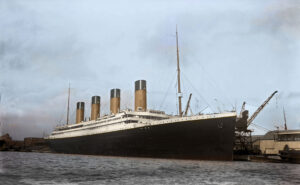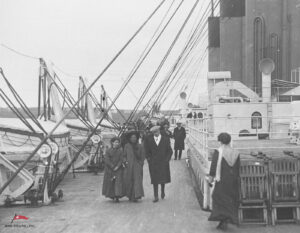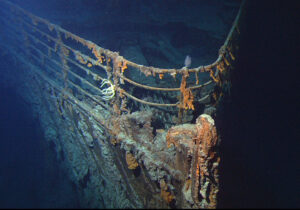Aftermath of Disaster – How Many People Survived the Titanic?
The RMS Titanic is not just a ship; it is a symbol of human ambition and tragedy. When it sank on its maiden voyage in 1912, it captured the world’s attention and left an enduring legacy. Today, the fascination with the Titanic continues, thanks in large part to the efforts of RMS Titanic Inc.
This organization is dedicated to exploring and preserving the wreck, ensuring that the story of the Titanic and its passengers is never forgotten. A crucial aspect of their mission is helping people understand how many people survived the Titanic, who and how many perished, and what were their stories.
The Titanic’s Fateful Voyage

The Titanic set sail on its maiden voyage from Southampton to New York on April 10, 1912. The ship was a marvel of engineering, considered unsinkable due to its advanced safety features. However, on the night of April 14, 1912, disaster struck. The Titanic collided with an iceberg, which caused catastrophic damage to its hull. The collision led to the tragic sinking of the ship.
The Passengers and Crew Aboard the Titanic
The Titanic carried approximately 2,224 people, including passengers and crew. Passengers were divided into three classes: first, second, and third. The first class included some of the wealthiest and most prominent individuals of the time, such as John Jacob Astor IV and Benjamin Guggenheim. The crew consisted of about 885 members, ranging from officers and engineers to stewards and kitchen staff.
The Sinking of the Titanic
After the collision at 11:40 PM, the Titanic began to take on water rapidly. The crew and passengers were initially confused and unaware of the impending danger. Lifeboats were launched, but there were not enough to accommodate everyone on board. Women and children were given priority, leading to chaotic and emotional scenes. By 2:20 AM, the Titanic broke apart and sank, leaving a vast debris field on the ocean floor.
Survival Rates by Class and Gender

Survival rates varied significantly among different classes and genders. In first class, a higher percentage of women and children survived compared to men. Second class saw a similar trend, though fewer passengers overall survived. The third class had the lowest survival rates, with many passengers unable to reach the lifeboats in time. Overall, about 32% of those on board survived the disaster, with women and children having the highest chances of survival.
The Aftermath for Survivors
The RMS Carpathia arrived at the disaster scene several hours after the Titanic sank. It rescued around 705 survivors from the lifeboats. These survivors faced harsh conditions, including cold weather and emotional trauma. Notable survivors like Margaret “Molly” Brown played significant roles in comforting and organizing fellow survivors. Medical staff on the Carpathia provided care for injuries, while survivors shared blankets and clothing to stay warm.
Carpathia took three days to reach New York, slowed by pack ice, fog, thunderstorms, and rough seas. Despite these challenges, Carpathia’s wireless system enabled it to pass news about the disaster to the outside world. Initial reports were confusing, but later confirmed the tragic loss of most passengers and crew. The news attracted crowds to White Star Line’s offices in several cities. Southampton, which lost many crew members, was particularly hard hit.
When Carpathia docked in New York, it was greeted by 40,000 people in heavy rain. Relief organizations provided immediate aid to survivors. Many passengers quickly left New York to stay with relatives. Some wealthier survivors chartered private trains, while the Pennsylvania Railroad offered a special train to Philadelphia. Titanic’s surviving crew members were accommodated on the SS Lapland. Notably, two of the surviving crew members, Violet Jessop and Arthur John Priest, also survived the sinking of the HMHS Britannic and were aboard the RMS Olympic when it was hit by another ship in 1911.
The Unfortunate Victims
The sinking of the Titanic claimed the lives of over 1,500 people, including the chief naval architect Thomas Andres, the captain Edward Smith, and John Jacob Astor IV. Many bodies were lost to the sea, making recovery efforts challenging. Despite these difficulties, ships like the CS Mackay-Bennett played crucial roles in retrieving the victims’ remains. In total, recovery teams managed to retrieve 333 bodies. These efforts involved considerable coordination and resources. Recovered bodies were either buried at sea or transported to Halifax, Nova Scotia, for identification and burial.
The process of identifying the victims was meticulous, with personal items and physical characteristics documented to ensure accuracy. Memorials and cemeteries in Halifax and other locations honor those who perished in the tragedy. These memorials serve as a poignant reminder of the lives lost and the impact of the disaster on families and communities around the world.
The Legacy of the Titanic’s Passengers and Crew
The stories of the Titanic’s passengers and crew have left an indelible mark on history. Their experiences led to significant changes in maritime safety regulations, ensuring that such a disaster would not happen again. Efforts to remember and honor the victims and survivors continue to this day, through memorials, exhibitions, and educational programs.
RMS Titanic Inc. and the 2024 Titanic Expedition

RMS Titanic Inc. has dedicated itself to preserving the history of the Titanic through exploration and research. They have conducted numerous expeditions to the wreck site, recovering artifacts and providing valuable insights into the ship’s final moments. In July 2024, they will embark on another significant expedition. This mission aims to document the current condition of the wreck, discover new artifacts, and engage the public through educational initiatives.
The 2024 Titanic expedition will utilize advanced technologies to capture high-resolution images and data. These efforts will help preserve the Titanic’s legacy and provide new information about the ship’s condition. By sharing their findings, RMS Titanic Inc. hopes to inspire future generations to continue exploring and learning about this historic event.
Follow RMS Titanic Inc. for More Information
The Titanic’s sinking remains a poignant reminder of human vulnerability and resilience. Understanding the stories of those who survived and those who perished is essential to preserving their legacy.
RMS Titanic Inc.’s work in exploring and documenting the wreck site ensures that the lessons learned from this tragedy are never forgotten. Support their mission and stay informed about their 2024 expedition to contribute to the ongoing preservation of the Titanic’s history.
